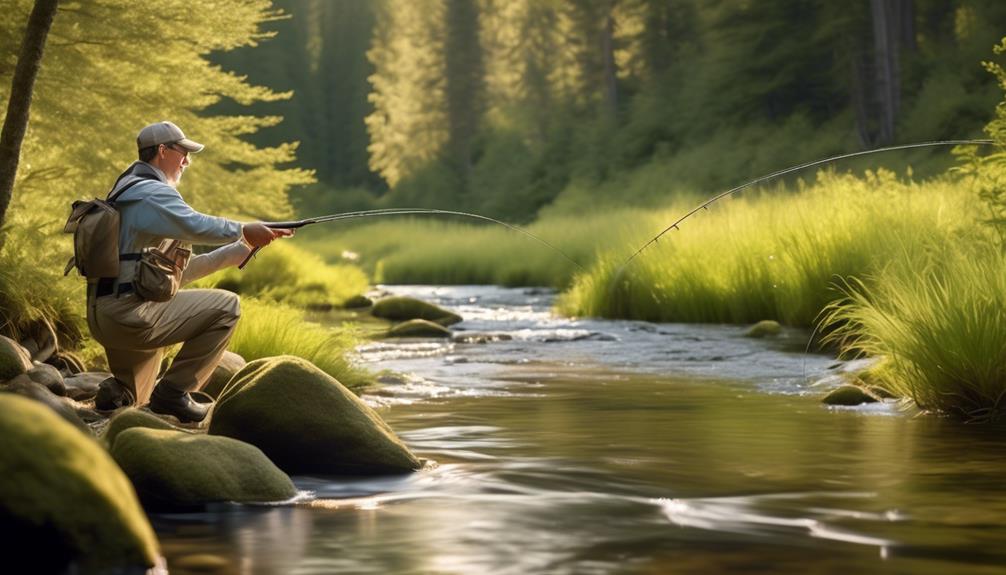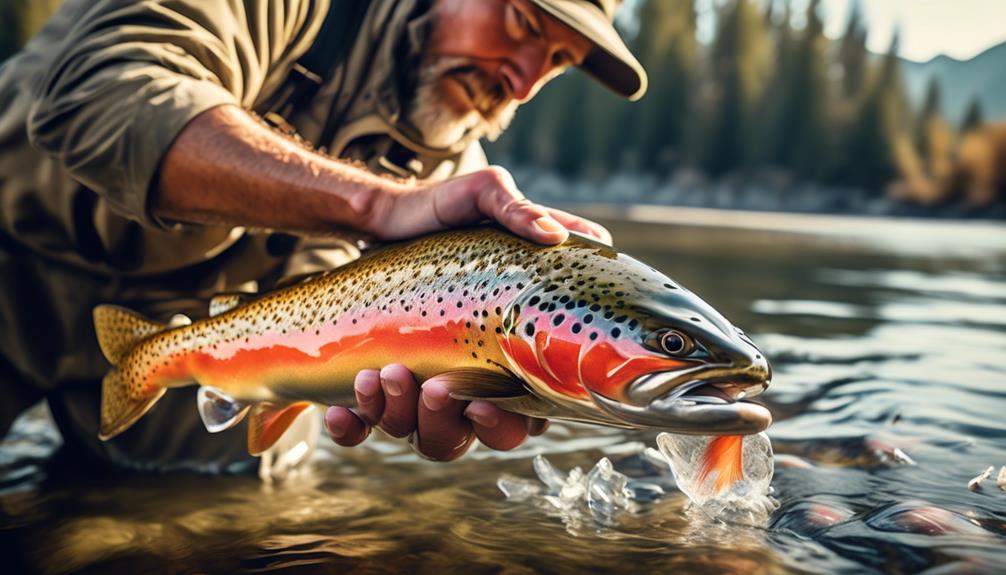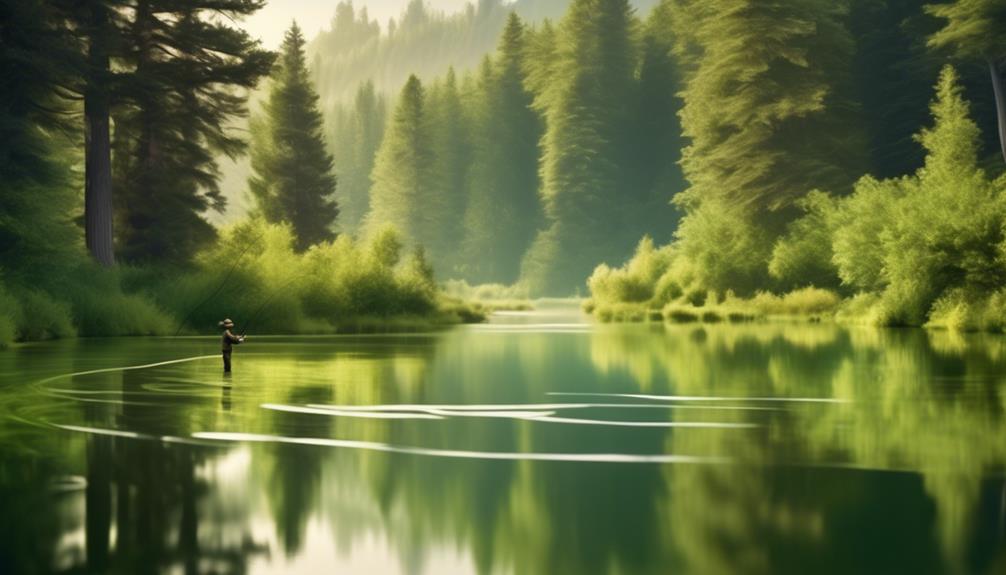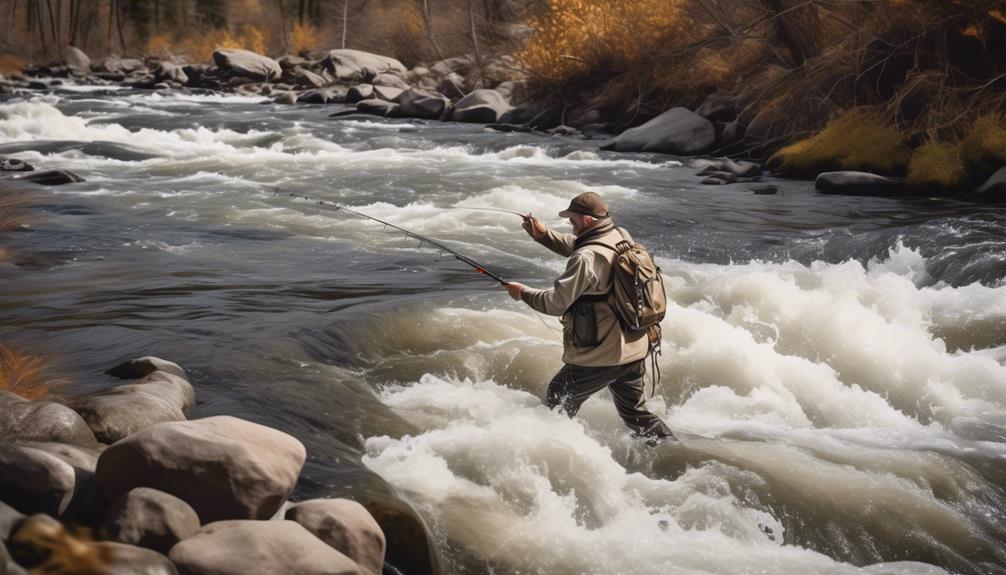When it comes to mastering trout fly fishing in small streams, understanding the intricacies of the ecosystem, selecting the right gear, and perfecting your approach are key.
Imagine yourself standing in a secluded stream, surrounded by the peaceful sounds of nature, and the challenge of coaxing elusive trout from their hiding spots. As you navigate the narrow waters, each bend presents a new puzzle to solve. How can you effectively navigate the obstacles, and present your fly in a way that entices the trout to strike?
There are countless intricacies to explore, and the satisfaction of mastering them is unparalleled.
Understanding Small Stream Ecosystems
To understand small stream ecosystems, observe the interplay of various elements such as water flow, substrate composition, and vegetation. These elements create a unique environment that supports a diverse range of insect life, which is crucial for the health of small streams. Small stream insect life serves as a vital food source for fish, such as trout, making it an essential component of the ecosystem.
Streamside vegetation plays a crucial role in the life cycle of small stream insects. It provides shade, which helps regulate water temperature and maintain oxygen levels, creating an optimal habitat for insect development. Additionally, fallen leaves and woody debris from streamside vegetation serve as a food source for aquatic insects, further contributing to the intricate food web within small streams.
Understanding the importance of streamside vegetation and small stream insect life is fundamental for trout fly fishing. As an angler, recognizing the specific types of insects that inhabit the stream and the vegetation that supports them can significantly improve your fishing experience. By observing the interactions between the insects, vegetation, and water flow, you can better anticipate where trout are likely to be feeding and adjust your fishing tactics accordingly.
In essence, the delicate balance of small stream ecosystems relies on the interdependence of water flow, substrate composition, and vegetation to sustain diverse insect life. This understanding is invaluable for anglers seeking to master the art of trout fly fishing in small streams.
Selecting the Right Fly Fishing Gear
Looking to enhance your trout fly fishing experience in small streams? Choosing the right fly fishing gear is crucial for success. When it comes to selecting the perfect fly, consider the specific insects present in the stream. Matching the hatch accurately can greatly improve your chances of enticing trout to bite.
Start by selecting the appropriate fly rod and reel. For small streams, a lightweight rod between 7 to 8.5 feet with a light action is ideal for navigating tight spaces and casting with precision. A reel with a smooth drag system and sufficient backing capacity is essential in case you hook a larger trout in a confined area.
Next, carefully choose your fly line. A weight-forward floating line is versatile and suits small stream fishing well. It allows for delicate presentations and precise casting, crucial in these intimate environments.
When it comes to selecting the perfect fly, observe the insect activity around the stream. Look under rocks and along the banks to identify the prevalent insects. Choose a fly pattern that closely resembles the insects in the area. Additionally, carrying a variety of dry flies, nymphs, and streamers can cover a range of potential feeding behaviors of the trout.
Matching the hatch accurately by selecting the right fly fishing gear will significantly improve your success in small stream trout fly fishing.
Mastering Stealth and Approach
Master your stealth and approach to quietly and effectively maneuver along the small stream for optimal trout fly fishing success. When it comes to mastering stealth and approach for small stream fly fishing, several key techniques can significantly improve your chances of a successful catch. Here are some essential tips to consider:
- Streamside Camouflage: Blend in with your surroundings by wearing clothing that matches the colors of the streamside vegetation. This will help you remain inconspicuous and avoid startling the trout.
- Stalking Techniques: Move slowly and deliberately, taking care to avoid sudden movements that could alert the trout to your presence. Use the natural cover to your advantage, such as rocks and trees, to conceal your approach.
- Quiet Movement: Minimize noise by stepping softly and avoiding unnecessary splashing or disturbance in the water. Trout have keen senses and can be easily spooked by loud or abrupt movements.
- Precise Casting Techniques: Practice accurate and delicate casting to place your fly gently on the water's surface. This will mimic natural insect behavior and reduce the likelihood of startling the trout.
- Awareness of Surroundings: Pay attention to the flow of the stream, the direction of the wind, and any potential obstacles that could affect your approach. Being mindful of your environment will help you navigate the stream more effectively.
Navigating Small Stream Obstacles
Navigating small stream obstacles requires careful observation and strategic maneuvering to ensure a smooth and uninterrupted fishing experience. When wading through small streams, it's crucial to prioritize streamside safety.
Always watch your step, as the rocky terrain and slippery riverbeds can present potential hazards. Take note of overhanging branches, submerged rocks, and hidden drop-offs, adjusting your path accordingly to avoid accidents. Additionally, be mindful of the current strength and depth, especially after heavy rainfall, to prevent being swept off your feet.
Handling fish stress is another essential aspect when navigating small stream obstacles. Once you've successfully hooked a trout, it's important to minimize the stress on the fish during the landing process. Maneuver carefully to guide the fish away from potential snags and underwater obstructions. Avoid excessive chasing or playing the fish for too long, as this can exhaust the trout and make it more susceptible to injury.
After landing the fish, quickly and gently remove the hook, minimizing the time it spends out of the water. Always support the fish in the water until it's ready to swim away on its own, ensuring its well-being after the catch.
Perfecting the Art of Presentation
When fly fishing for trout in small streams, honing your presentation skills is vital for enticing wary fish in the clear, shallow waters. To perfect the art of presentation, consider the following tips:
- Fly Placement: Carefully observe the water and identify the likely holding spots for trout. Make accurate casts to place your fly precisely in those areas, taking into account the current and potential feeding lanes.
- Line Control: Mastering line control is crucial for a natural drift. Mend the line to prevent drag and maintain a drag-free presentation. Learn to manipulate the line to adjust the fly's drift and keep it in the trout's feeding zone for as long as possible.
- Stealthy Approach: Approach the water with caution, keeping low and minimizing noise and movement. Trout in small streams are easily spooked, so a stealthy approach is essential for a successful presentation.
- Short Casts: In the confined space of small streams, shorter casts are often more effective. Practice accurate short casts to target specific areas and avoid spooking fish with unnecessary splashes.
- Reading Water: Develop the ability to read the water to anticipate where the trout might be holding. Understanding the behavior of trout in different water conditions will improve your fly placement and presentation.
Mastering these presentation techniques will significantly increase your success in small stream trout fly fishing. Remember, precision in fly placement and control of your line are the keys to enticing those elusive trout.
Reading Small Stream Water
Understanding the nuances of small stream water is essential for successful trout fly fishing. When reading the water, it's crucial to identify feeding lies and current seams. Look for areas where the water slows down and where it picks up speed. Trout often position themselves in feeding lies, which are spots where they can conserve energy while being in a prime position to intercept food. These are often found behind rocks, logs, or other obstructions that break the current. Current seams, where fast and slow water meet, are also prime feeding spots for trout. They provide a natural conveyor belt of food for the fish.
In addition to identifying feeding lies and current seams, reading the water depth and velocity is equally important. Water depth is a key factor in determining where trout may be holding. They seek areas with the right depth that provides cover and protection from predators. Shallow riffles, deep pools, and undercut banks are all potential holding spots.
Pay attention to the velocity of the water as well. Trout prefer areas with moderate current where they can hold comfortably without expending too much energy. These spots offer a balance of food delivery and oxygenation.
Executing Effective Small Stream Casts
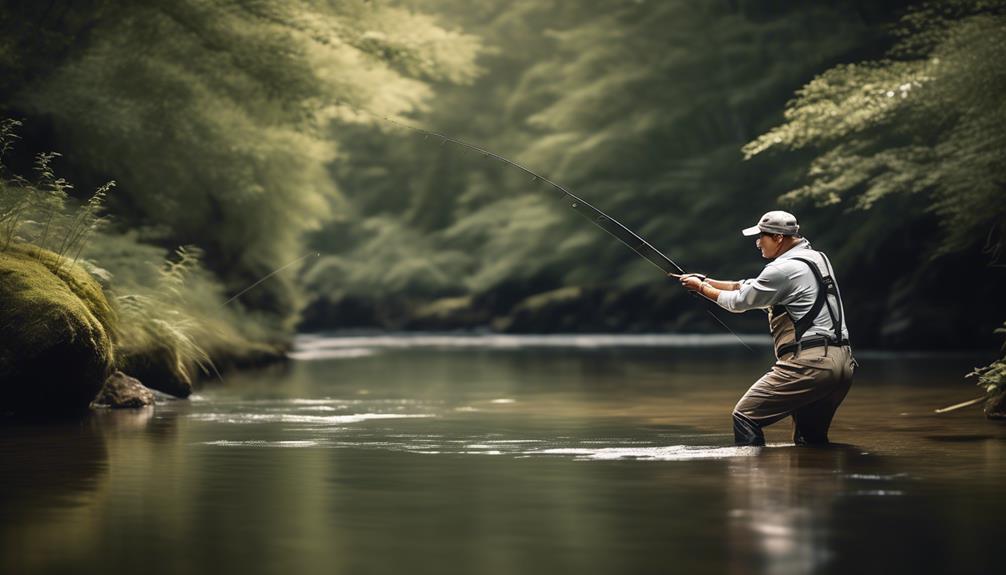
To effectively cast in small streams, focus on precise placement and delicate presentations to entice wary trout. Small streams require a different approach compared to larger rivers. Here are some tips to help you execute effective small stream casts:
- Master the Roll Cast: In small streams, overhanging branches and tight spaces can limit your backcast. The roll cast allows you to present your fly accurately without needing much room for a backcast.
- Utilize Sidearm Casting: By using a sidearm casting technique, you can keep your line low and parallel to the water, reducing the chances of spooking the trout.
- Employ Reach Mends: To achieve a drag-free drift in narrow streams, use reach mends to reposition your line mid-drift. This technique helps in presenting the fly naturally to the fish.
- Make Use of Bow and Arrow Casting: This method allows you to cast accurately in confined spaces by shooting the line forward with minimal backcasting room.
- Understand Streamside Entomology: Observing the insects near the water will help you select the right fly pattern and present it in a convincing manner. Understanding the specific insects present in the stream will greatly improve your chances of success.
Catch and Release Best Practices
After mastering effective small stream casts, the next crucial step is understanding and implementing catch and release best practices to ensure the preservation of trout populations. When practicing catch and release, it's important to consider fish behavior and minimize any potential environmental impact.
Understanding fish behavior is essential for successful catch and release. When reeling in a trout, it's crucial to minimize the time it spends out of the water. Keeping the fish in the water as much as possible reduces stress and increases its chances of survival after being released. Additionally, handling the fish with wet hands or using a rubberized net helps protect its delicate outer layer, ensuring it can continue to thrive in its natural habitat.
Minimizing environmental impact is equally vital. Avoiding barbed hooks and using artificial lures instead of live bait can prevent unnecessary harm to the fish. It's also important to release the trout gently, allowing it to swim away on its own rather than tossing it back into the water.
Frequently Asked Questions
What Are the Best Tactics for Dealing With Windy Conditions When Fly Fishing in Small Streams?
When fly fishing in small streams and dealing with windy conditions, use casting techniques to keep your line low and avoid snags. Choose weighted flies for better control, read water currents for optimal placement, and approach stealthily for success.
How Can I Effectively Locate and Target the Biggest Trout in Small Stream Environments?
To effectively locate and target the biggest trout in small streams, you must master the stealthy approach and proper casting techniques. Reading water and navigating obstacles are crucial for finding the best spots.
Are There Any Specific Fly Patterns That Work Best for Small Stream Fishing, and How Can I Tie Them Effectively?
To effectively target trout in small streams, focus on using effective fly patterns. When tying these flies, pay attention to the details to ensure they are well-constructed. Choosing tackle and perfecting your casting techniques will also enhance your success.
What Are Some Advanced Strategies for Dealing With Spooked or Selective Trout in Small Streams?
When dealing with spooked or selective trout in small streams, focus on a stealthy approach and understanding trout behavior. Use presentation techniques to match the hatch and entice the trout, adapting to their behavior.
How Can I Accurately Judge the Depth and Speed of the Water in Small Streams in Order to Choose the Right Presentation for My Fly?
To judge the depth and speed of the water in small streams for the right fly presentation, focus on reading the water current and use casting techniques to gauge depth perception. This will help you accurately choose your fly presentation.
Conclusion
So, next time you head out to fish in a small stream, remember to carefully observe the ecosystem. Choose the right gear, approach stealthily, and navigate obstacles. Present your fly effectively and execute precise casts.
By mastering these skills and practicing catch and release, you can become a successful trout fly angler. At the same time, you will be preserving the delicate small stream environment for future generations to enjoy.
Tight lines and happy fishing!
